Japan
Wood Products Prices
Dollar Exchange Rates of 10th
April
2021
Japan Yen 109.67
Reports From Japan
Vaccination roll-out for
elderly
Japan¡¯s vaccination programme began 12 April around
four months after the start of inoculations in the United
States and the United Kingdom. This delay has generated
criticism of the government¡¯s handling of vaccine
procurement.
Business sentiment tilts positive
Business sentiment among large companies has been
improving and the ¡®Tankan¡¯ survey by the Bank of Japan
(BoJ) said the index for big manufacturers was positive in
March, a considerable improvement over the negative
level in the December survey.
The ¡®tankan¡¯ measures corporate sentiment by subtracting
the number of companies saying business conditions are
negative from those responding they are positive.
The March survey supports the view of the BoJ that the
economy continues to recover ¡°moderately¡±.
Despite the growing optimism among large manufactures,
small and medium sized companies are struggling and
with less take-home pay and rising uncertainty over the
direction of the pandemic retail sales are weak and fell for
the third straight month in February.
Against this background the economy looks set to have
contracted in the first quarter of 2021.
See:
https://www.fxempire.com/forecasts/article/usd-jpyfundamental-daily-forecast-data-indicates-japanese-economy-iscontracting-during-current-quarter-714517
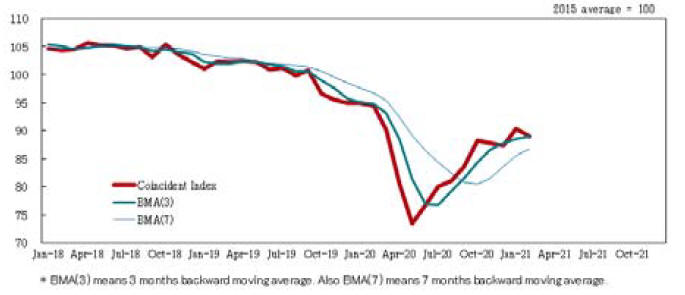
Start of vaccinations boosts consumer
sentiment
Since the beginning of 2021 consumer confidence has
been improving as has the willingness of consumers to
purchase durable goods the purchase of which is the first
to decline when times are tough. The rise in sentiment has
been put down to the beginning of the corona vaccination
programme in the country.
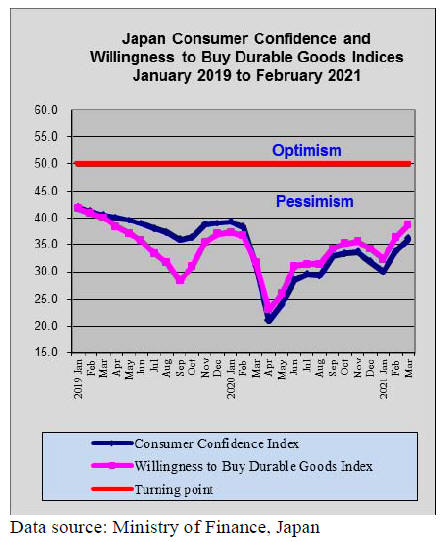
Weak yen good news for Bank of Japan
Since the beginning of this year the yen/dollar exchange
rate has been in the range 107-109 yen to the dollar. This
exchange rate is welcome news for the Bank of Japan as it
seeks to revive the export dependent economy.
The down side of the weaker yen is that the cost of
imports rises and this could further dampen domestic retail
sales which dropped a further 1.5% in February. It is
anticipated that Japan's economy contracted in the first
quarter partly due to falling consumer spending.

Foreign markets offer hope for house
builders
A Japan Lumber Reports survey has found orders placed
with the major builders in Japan was down 5% in
February. This marks two consecutive monthly declines.
In contrast the survey found builders of low cost homes
are doing well with order values up by 12% in February
marking ten consecutive monthly increases.
With a declining and aging population Japanese house
builders are developing straegies to maintain sales, one of
which is to nuture overseas projects.
The Japanese house builder Sekisui House has partnered
with Homes England and the UK developer Urban Splash
to build over 400 modular homes on a site in Northstowe,
Cambridgeshire, UK. This will be the first project
completed by the three-way partnership.
See:
https://www.insidehousing.co.uk/news/news/japans-biggesthouse-builder-delivers-400-modular-homes-in-homes-englandpartnership-70046
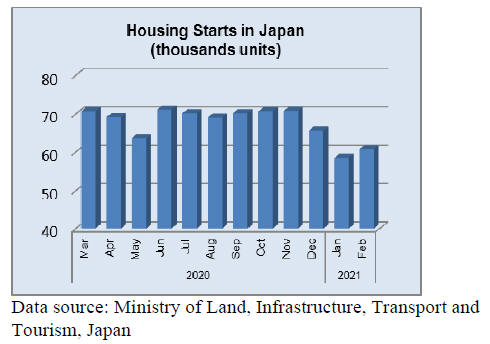
Import update
Wooden door Imports
As was the case in January 2021, China and the
Philippines dominated Japan¡¯s sources of wooden doors
(HS441820) but their combined shared of total imports
slid once more with shippers in SE Asia especially
Indonesia and Malaysia grabbing a higher market share.
China accounted for 52% of the value of February imports
of wooden doors followed by the Philippines at 29% and
Indonsia at 6%. Year on year, February imports of wooden
doors were up 38% and month on month February imports
were 18% higher.
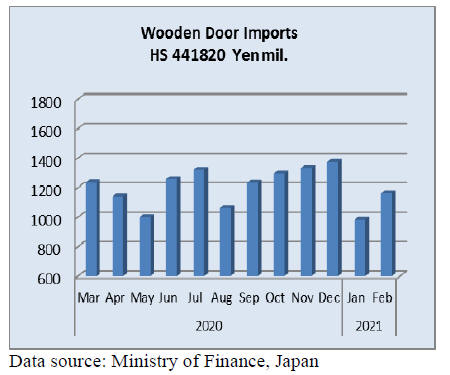
Wooden window imports
The value of February 2021 imports of wooden windows
(HS441810) was little changed from a year earlier but
compared to the value of imports in January there was a
13% increase. Three shippers, China (49%), the US (25%)
and the Philippines (23%) accounted for most of Japan¡¯s
wooden window imports in February and all saw their
share of imports rise compared to January.
Year on year February 2021 imports of wooden windows
were flat but month on month there was a 13% increase.

Assembled wooden flooring imports
Shipments of assembled wooden flooring (HS441871-79)
from China accounted for the largest share (70%) of
Japan¡¯s imports as they have done for several years.
In February this year shippers in Malaysia captured
the
number two spot. HS441875 continued to dominate
Japan¡¯s imports of assembled flooring in February 2021
but, as a proportion of all wooden floor arrivals in Japan,
there was a decline in this category with a corresponding
rise in imports of HS441879.
Year on year, the value of Japan¡¯s imports of assembled
wooden flooring (HS441871-79) rose 8% and month on
month there was a 23% increase building on rises for each
month since December 2020.
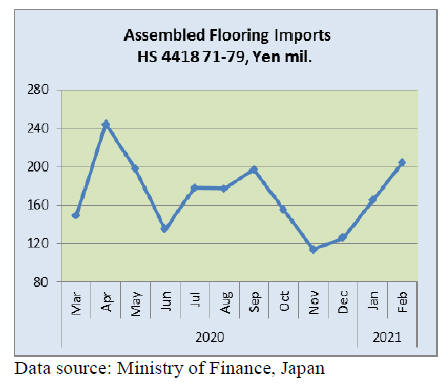
Plywood imports
After three consecutive monthly increases in the volume
of plywood imports there was a correction in February and
each of the main suppliers, Malaysia, Indonesia, Vietnam
and China saw export shipments drop.
Malaysia and Indonsesia account for most of Japan¡¯s
imports of plywood but exporters in Vietnam continue to
enjoy a sizeable share of plywood import volumes which
are now twice the volume shipped to Japan from China.
Of the various categories of plywood imports of
HS441231 accounted for 89% of February 2021 imports
with HS441234, the second highest category, accounting
for just 6%.
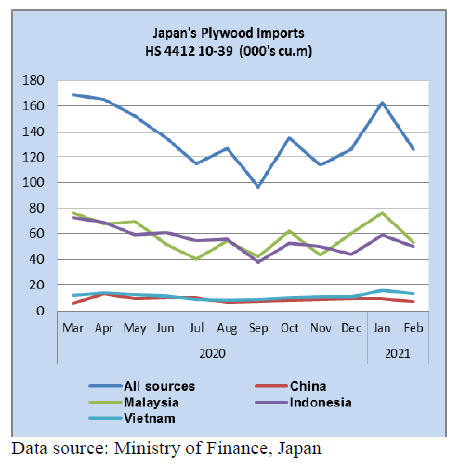 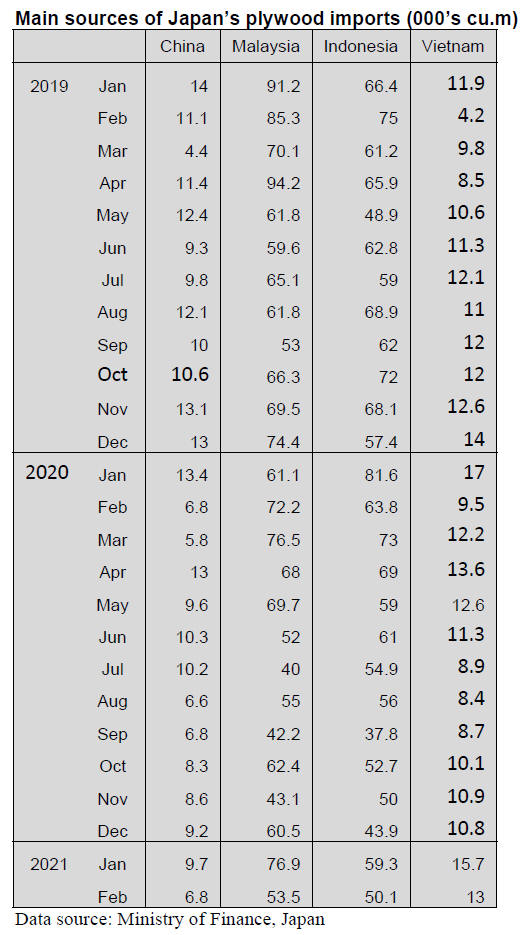
Trade news from the Japan Lumber Reports (JLR)
The Japan Lumber Reports (JLR), a subscription trade
journal published every two weeks in English, is
generously allowing the ITTO Tropical Timber Market
Report to reproduce news on the Japanese market
precisely as it appears in the JLR.
For the JLR report please see:
https://jfpj.jp/japan_lumber_reports/
Sales of major house builders in February
Ordered value major eight builders in February is down by
5% and this is two straight months decline. By declaration
of the state of emergency since early January, visitors to
the house exhibition sites drooped by about 50%, which
influenced February orders. Meantime, low cost builders
continue active and three builders¡¯ order value in February
is 12% up and this is ten consecutive months increase over
the same month a year earlier.
The demand to live in suburban areas continues and
acquisition of necessary properties influences orders of
house sales.
Number of visitors to the house exhibition sites was
increasing until the declaration of the state of emergency
in last January and the orders were recovering but tide
changed again since last January.
Buyers¡¯ attitude changed. They request brochures by
website and after examining brochures at home and focus
on target then visit house exhibition site so request for
brochures by website continues busy. With this trend, time
from visiting the site and concluding the deal becomes
shorter than before.
This means declining visitors is not necessarily mean
declining sales because visitors are now more serious
potential buyers.
Low cost builders and builders of units built for sale enjoy
busy market by active demand to live in urban areas so
they say if there is property, house can be sold in no time.
By eight major builders, ordered value compared to the
same month a year earlier in February is 95% while low
cost three builders in February is 112%.
Higher prices of European OSB
Market prices of European OSB are climbing. Reasons are
increasing demand in Europe, higher freight by container
shortage and inflating adhesive cost. Orders to the
manufacturers are swelling and it is hard to have
production for Japan market.
Delay of shipment by container shortage is getting critical.
It is hard to secure containers. Cargoes for shipment are
accumulated at shipping ports. January scheduled cargoes
still remain at loading port in middle of February without
any containers. Containers returning from Asia are not
coming back and it needs premium freight like 50% to
have containers in tight supply.
Adhesive (MDI) supply started getting tight since last July
2020 and the prices are inflating particularly after Chinese
demand came back in last February and at the same time,
MDI plant in the U.S.A. suffered slow production by cold
waves so worldwide supply of MDI is getting tight.
European OSB manufacturers say that adhesive supply is
now based on quota and some manufacturers are down
because of shortage of adhesive. Export prices for Japan
have started climbing since middle of 2020.
South Sea logs and lumber
Both demand and supply of South Sea logs are low. The
demand decreases largely in Japan after last plywood mill
stops operation and other mills shift to use other species or
veneer so log demand practically died in Japan.
Chinese made laminated free board prices are climbing.
Demand in Japan is not so active but dealers continue to
purchase to cover dropping inventory. Tropical hardwood
lumber demand is recovering for truck body but it is
limited demand.
Serious shortage of containers
Container shortage continues worldwide. Export business
in China is very active and China looks for containers
aggressively. Normally inbound cargoes are loaded and
containers are shipped back to China but demand of empty
containers is so strong in China that it pays premium to
bring containers back without any inbound cargoes and
some empty containers bound for Japan from North
America abruptly changed to go to China.
In short, China scrapes containers at any cost now. This
influences wood products import of Japan. North
American and European suppliers are tired of low sales
prices for Japan then securing containers is another
headache so cargoes for Japan are waiting for containers at
every loading ports. This delays shipments so supply
shortage in Japan gets worse by not only supply side
reason but also shipping problem. The suppliers are
reducing offer volume for Japan with reason of container
shortage and higher freight.
Trans-shipment of container cargoes is delayed. European
cargoes for Japan normally stop at Shanghai, China or
Pusan, Korea for transshipment but this takes time because
of congestion. Containers with hemlock genban scheduled
to arrive in January held for a month in Shanghai for
transshipment and finally arrived in late February so the
genban users operate hand to mouth by the delay. Future
containers with genban are being held in Shanghai so the
supply shortage will continue.
European wood products suppliers struggle to secure
containers for Japan so shipment of lamina and structural
laminated lumber for the first quarter has been delayed.
The suppliers increase sales for European market, where
land transportation is possible so the supply for Japan
would decline more. Second quarter negotiations for
lamina and laminated lumber should start shortly but the
container shortage remains as serious problem.
Russian lumber export business has the same problem.
Export cargoes are piling up at shipping ports in the
Russian Far East so the ports refuse to bring railcars into
port. Transshipment at Pusan, Korea for Japan sea side
ports takes more than two weeks now by congestion.
Okura developed new type concrete forming panel
Okura Industrial Co., Ltd., (Kagawa prefecture) developed
new type of concrete forming panel. Concrete panel has
been imported tropical hardwood plywood but what
Okura developed is made of water proof particleboard and
domestic softwood plywood as base materials. Weight is
10% lighter than tropical hardwood concrete forming
plywood.
Particleboard has forest certificate and domestic softwood
plywood is sustainable material so the product is
environmentally friendly product. Performance of the
product is almost same as imported hardwood concrete
forming plywood.
Particleboard is 2.7 mm thick made of FSC-COC certified
rubber tree wood chip and 9 mm thick domestic cypress
plywood. This composite panel is coated with high density
polyethylene sheet. Size is 12 mm thick 900x1800 mm.
The weight per sheet is about 11 kilogram.
After the supply of concrete forming plywood from South
East Asian countries has been getting tight by declining
raw materials. This new product can be supplied stably
and the price is also stable unlike South Sea plywood,
which supply is unstable by weather and the prices
fluctuate.
|